| No. 41 | |||||||||||||
|---|---|---|---|---|---|---|---|---|---|---|---|---|---|
| Position: | Running back | ||||||||||||
| Personal information | |||||||||||||
| Born: | August 18, 1941 Garfield, Georgia, U.S. | ||||||||||||
| Height: | 6 ft 2 in (1.88 m) | ||||||||||||
| Weight: | 219 lb (99 kg) | ||||||||||||
| Career information | |||||||||||||
| High school: | Carle Place (North Hempstead, New York) | ||||||||||||
| College: | Ohio State | ||||||||||||
| NFL draft: | 1964 / Round: 4 / Pick: 49 | ||||||||||||
| AFL draft: | 1964 / Round: 1 / Pick: 3 | ||||||||||||
| Career history | |||||||||||||
| Career highlights and awards | |||||||||||||
| |||||||||||||
| Career NFL statistics | |||||||||||||
| |||||||||||||
| Player stats at PFR | |||||||||||||
Matthews Snell (born August 18, 1941) is an American retired professional football player who was a running back for the New York Jets of the American Football League (AFL) and National Football League (NFL). He was Jets' owner Sonny Werblin's first coup, prior to his 1965 acquisition of Joe Namath. A powerful fullback out of Ohio State University, Snell's 1964 signing jolted the crosstown Giants, who didn't draft Snell until the fourth round, and offered him a fraction of what the Jets gave him as their first-round choice.
Born to Isaac and Annie, [1] Snell attended Carle Place High School in the one-square-mile town of Carle Place, New York, where his picture resides in the Carle Place High School Athletic Hall of Fame. Snell played right halfback on a team that lost only two games while he started. He was awarded Newsday 's Thorp Award for 1959 as the outstanding high school football player in Nassau County.
At Ohio State University, Snell was a three-year starter and a consummate team player, active on both sides of the ball. In 1961, he played right halfback, often blocking for fullback Bob Ferguson or left halfback Paul Warfield. In 1962, Snell was moved to defensive end. In 1963, Snell's senior year, he was named starting fullback, going on to rush for 491 yards and 5 touchdowns. [2] At the end of his senior season, Snell was named his team's most valuable player.
Snell was named to the Ohio State Football All-Century Team in 2000 as a defensive end.
In his rookie year with the New York Jets, Snell rushed for a team-record 180 yards against the Houston Oilers on his way to a 945-yard season and AFL Rookie of the Year honors. Snell went on to become an AFL Eastern Division All-Star in 1964 and 1966, and the Sporting News All-AFL fullback in 1969.
Snell's defining moment came in Super Bowl III when the AFL champion Jets played the heavily-favored NFL champion Baltimore Colts. Although slowed by knee injuries, Snell was a key player in the Jets' ball-control offense during the 16–7 upset victory. He carried the ball 30 times for a then-Super Bowl record of 121 yards, and in the second quarter went four yards around left end to score the Jets' only touchdown, a score that marked the first time an AFL team had led in a Super Bowl. He also helped set up a trio of Jim Turner field goals that finally put the game away for the Jets in the second half, securing the AFL's first Super Bowl win in the league's penultimate season.
During his career, Snell was well known for his rushing, but also became an important part of the Jets' pass-blocking scheme. Toward the end of his career, Snell became one of the first third-down specialty backs, primarily because he was so good at protecting Joe Namath. He was also reported to have helped teach pass-blocking to Jets running backs during his career.
Snell suffered multiple injuries in his career, including torn knee cartilage in 1967 and a torn Achilles tendon in 1970. In 1971, he hurt his knee in the preseason and was diagnosed with a severe "knee bruise" and missed nine games. In 1972, in Week 4 versus the Miami Dolphins, he suffered a ruptured spleen. The injury was so severe that his spleen had to be removed, ending his season. He decided right then that he couldn't play anymore, though he didn't formally announce his retirement until the following March. [1] He only played in a total of 12 games in what would be his final three seasons.
In 1973, Snell appeared in the first Miller Lite beer commercial. According to the San Francisco Chronicle , "The campaign would feature a collection of middle-aged sports stars and become something of a status symbol for retired athletes for the next 17 years." [3]
After his playing career in 1973, he sold his restaurant, Matt Snell's Fifth Down, to focus on his new company, Defco Securities, Inc. (of which he is one of the four partners). [1]
Snell and Emerson Boozer were inducted into the Jets' Ring of Honor on November 29, 2015 because they were partners in each other's success and that of the team. Snell did not accept the Jets' invitation to participate in the ceremony at MetLife Stadium, just as he consistently has refused the club's invitations to other alumni events for unspecified reasons ever since he retired. [4] In 2018, Snell revealed that the reason he hasn't spoken to the Jets was because the team's owner at the time he left, Leon Hess, refused to give him a reference for a future job in spite of both being promised he would receive one, and in spite of his work to build the team's success over his professional football career. [5]
| Legend | |
|---|---|
| Won the Super Bowl | |
| Bold | Career high |
| Year | Team | Games | Rushing | Receiving | Fumbles | |||||||||||
|---|---|---|---|---|---|---|---|---|---|---|---|---|---|---|---|---|
| GP | GS | Att | Yds | Avg | Y/G | Lng | TD | Rec | Yds | Avg | Lng | TD | Fum | FR | ||
| 1964 | NYJ | 14 | 14 | 215 | 948 | 4.4 | 67.7 | 42 | 5 | 56 | 393 | 7.0 | 41 | 1 | 0 | 0 |
| 1965 | NYJ | 13 | 13 | 169 | 763 | 4.5 | 58.7 | 44 | 4 | 38 | 264 | 6.9 | 35 | 0 | 3 | 0 |
| 1966 | NYJ | 12 | 12 | 178 | 644 | 3.6 | 53.7 | 25 | 4 | 48 | 346 | 7.2 | 25 | 4 | 3 | 0 |
| 1967 | NYJ | 7 | 5 | 61 | 207 | 3.4 | 29.6 | 13 | 0 | 11 | 54 | 4.9 | 21 | 0 | 2 | 0 |
| 1968 | NYJ | 14 | 14 | 179 | 747 | 4.2 | 53.4 | 60 | 6 | 16 | 105 | 6.6 | 39 | 1 | 2 | 1 |
| 1969 | NYJ | 14 | 13 | 191 | 695 | 3.6 | 49.6 | 34 | 4 | 22 | 187 | 8.5 | 54 | 1 | 5 | 1 |
| 1970 | NYJ | 3 | 3 | 64 | 281 | 4.4 | 93.7 | 19 | 1 | 2 | 26 | 13.0 | 27 | 0 | 2 | 0 |
| 1971 | NYJ | 5 | 0 | did not record any stats | ||||||||||||
| 1972 | NYJ | 4 | 0 | did not record any stats | ||||||||||||
| Career | 86 | 74 | 1,057 | 4,285 | 4.1 | 49.8 | 60 | 24 | 193 | 1,375 | 7.1 | 54 | 7 | 17 | 2 | |
Snell lives in New Rochelle, New York [1] with his wife Sharon, son Beau and daughter Jada. His grandson Donte played football for Holy Cross High School. [6] He is a partner in DEFCO Securities, Inc. and owns a restaurant in New York City. [7] He is the first cousin, twice removed of running back Benny Snell, with Benny Snell's grandfather being his first cousin. [8]
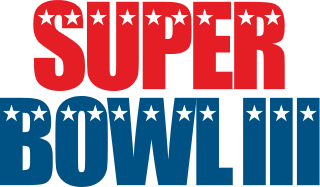
Super Bowl III was an American football game played on January 12, 1969, at the Orange Bowl in Miami, Florida. It was the third AFL–NFL Championship Game in professional American football, and the first to officially bear the trademark name "Super Bowl". Super Bowl III is regarded as one of the greatest upsets in both American football history and in the history of professional sports. The 19 1⁄2- points underdog American Football League (AFL) champion New York Jets defeated the National Football League (NFL) champion Baltimore Colts by a score of 16–7.

Joseph William Namath, nicknamed "Broadway Joe", is an American former football quarterback who played in the American Football League (AFL) and National Football League (NFL) for 13 seasons. He spent the majority of his career with the New York Jets. Namath played college football for the Alabama Crimson Tide, where he won the national championship as a senior, and was selected by the Jets first overall in the 1965 AFL draft.
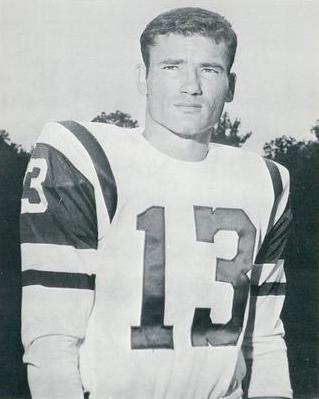
Donald Rogers Maynard was an American professional football player who was a wide receiver known for playing for the New York Jets in the National Football League (NFL). He also played with the New York Giants and St. Louis Cardinals; and the Shreveport Steamer of the World Football League (WFL).
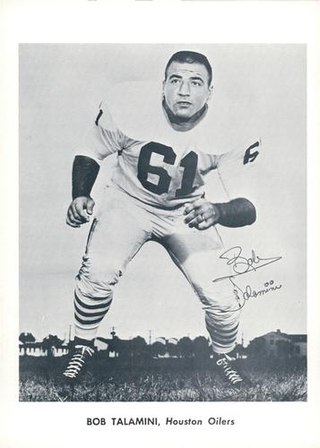
Robert Guy Talamini was an American professional football player who was a guard in the American Football League (AFL). He played college football for the Kentucky Wildcats, earning third-team All-SEC honors. He was selected by the Houston Oilers of the American Football League (AFL). His professional career began with the AFL's first training camp in 1960, and was capped the day the New York Jets stunned the NFL's Baltimore Colts in Super Bowl III on January 12, 1969.
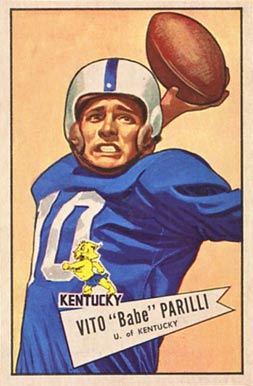
Vito "Babe" Parilli was an American football quarterback and coach who played professionally for 18 seasons. Parilli spent five seasons in the National Football League (NFL), three in the Canadian Football League (CFL), and 10 in the American Football League (AFL). He played college football at the University of Kentucky, where he twice received consensus All-American honors and won two consecutive bowl games.
Winston Cordell Hill was an American football offensive tackle who played in the American Football League (AFL) and National Football League (NFL), primarily with the New York Jets. He played college football for the Texas Southern Tigers.

Bobby Lee Bell Sr. is an American former football linebacker and defensive end who played for the Kansas City Chiefs of the American Football League (AFL) and the National Football League (NFL). He is a member of the Pro Football Hall of Fame, the College Football Hall of Fame, and was a member of the Chiefs' team that won Super Bowl IV against the Minnesota Vikings.

Eugene Edward "Mercury" Morris is an American former professional football player who was a running back and kick returner. He played for eight years, primarily for the Miami Dolphins, in the American Football League (AFL) as a rookie in 1969 then in the American Football Conference (AFC) following the 1970 merger with the National Football League (NFL).
Carl Richard Todd is an American former professional football player who was a quarterback for the New York Jets and New Orleans Saints of the National Football League (NFL) from 1976 to 1986. Like former Jets quarterback Joe Namath and Raiders quarterback Ken Stabler, he played college football for the Alabama Crimson Tide under coach Paul "Bear" Bryant. Todd was selected by the Jets in the first round of the 1976 NFL draft with the sixth overall pick.
Emerson Boozer is an American former professional football player who spent his entire career as a running back for the New York Jets in the American Football League (AFL) and National Football League (NFL). In the last year of separate drafts by the AFL and the NFL, Boozer signed with the AFL's Jets, rather than with an NFL team. He was a member of the Jets team that defeated the NFL's champion Baltimore Colts, 16–7, in Super Bowl III. Before joining the AFL, Boozer played college football at the Maryland State College, which is now the University of Maryland Eastern Shore.
In each year of its ten-year existence (1960–1969), numerous sports-news services named their choice for the American Football League's best first-year player. UPI selected a rookie for each of the ten seasons, while the Associated Press did selections from 1961 to 1966, which ended up with the same selections that UPI made. In 1967, AP instead selected Offensive and Defensive Rookie of the Years for the AFL, with the offensive choices matching the UPI selection.
Frank Alley Woodall is a retired American football player. He played college football at Duke where he was an All-American. He played several seasons with the Jets in the AFL and NFL. He started several games in 1970, 1971, and 1973, subbing for an injured Joe Namath. Woodall retired after spending the 1975 season on injured reserve with torn knee ligaments.
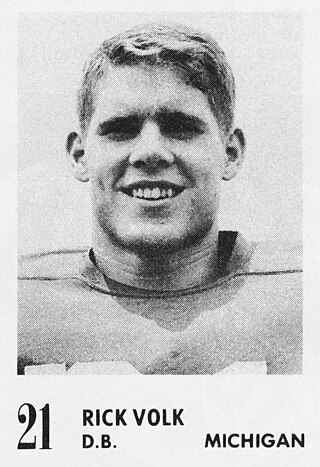
Richard Robert Volk is an American former professional football player who was a safety in the National Football League (NFL) for the Baltimore Colts, New York Giants, and Miami Dolphins. He retired with 38 career interceptions and 13 fumble recoveries, and totaled 574 yards on interception returns and 548 yards on punt returns.

The history of the New York Jets American football team began in 1959 with the founding of the Titans of New York, an original member of the American Football League (AFL); they began actual play the following year. The team had little success in its early years. After playing three seasons at the Polo Grounds, the team changed its name to the New York Jets, and moved into newly built Shea Stadium in 1964. In January 1965, the Jets signed University of Alabama quarterback Joe Namath to a then-record contract. The team showed gradual improvement in the late 1960s, posting its first winning record in 1967 and winning its only American Football League championship in 1968. By winning the title, New York earned the right to play in Super Bowl III against the champions of the National Football League (NFL), the Baltimore Colts. The Jets defeated the Colts in the game; in the aftermath of the upset, the AFL was deemed a worthy partner to the NFL as the two leagues merged.
James Clark Hudson was a professional American football defensive back. He was one of the first players to ever win a national championship in college and a Super Bowl as a professional. Hudson played for the New York Jets from 1965 to 1970, playing in both the American Football League (AFL) and National Football League (NFL). He started in Super Bowl III for the Jets, and made a key interception just before the end of the first half.
David Jon Herman was an American professional football player who played offensive guard for ten seasons in the American Football League (AFL) and National Football League (NFL). He played for the New York Jets from 1964 to 1973, having earlier played college football for Michigan State University.
Darrell John Elliott was an American professional football player who was a defensive tackle for seven seasons with the New York Jets of the American Football League (AFL) and later National Football League (NFL). He played college football for the Texas Longhorns, earning second-team all conference honors in the Southwest Conference (SWC). Elliot was selected by the Jets in the seventh round of the 1967 AFL Draft. He was a three-time all-star and three-time all-league selection, and won Super Bowl III with the Jets. He also played one season with the New York Stars of the World Football League, earning All-WFL honors once.

The Heidi Game or Heidi Bowl was a 1968 American Football League (AFL) game between the Oakland Raiders and the visiting New York Jets. The contest, held on November 17, 1968, was notable for its exciting finish, in which Oakland scored two touchdowns in the final minute to win the game 43–32. However, NBC, the game's television broadcaster, decided to break away from its coverage on the East Coast to broadcast the television film Heidi, which caused many viewers to miss the Raiders' comeback.

The Giants–Jets rivalry is an American football rivalry in the National Football League (NFL) between the New York Giants and New York Jets. It is an intra-city, interconference matchup between the two NFL teams based in the New York metropolitan area. Since 1984, both clubs have shared a home stadium. Thus, a Giants–Jets game can be referred to as "the shortest road trip in the league". It can also be referred to as a "sibling rivalry" since both teams play at and share the stadium.
The 1968 AFL Championship Game was the ninth annual title game of the American Football League, played on December 29 at Shea Stadium in Queens, New York City, New York. In a rematch of the notorious Heidi Game played earlier in the season, the New York Jets (11–3) of the Eastern Division hosted the defending champion Oakland Raiders (12–2) of the Western Division. Although the Raiders had the better record, the Jets were slight favorites. The Raiders had hosted a tiebreaker playoff game the week before against the Kansas City Chiefs (12–2) to determine the Western Division champion, while the Eastern champion Jets won their division outright and thus were idle.